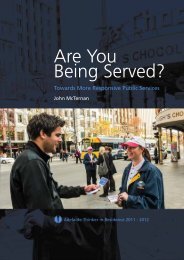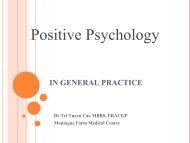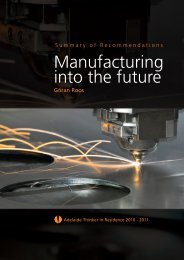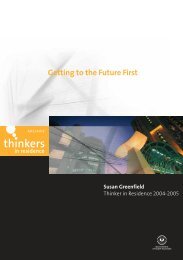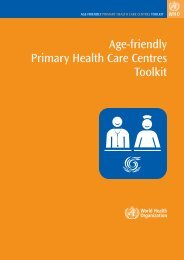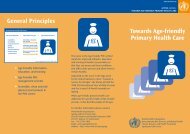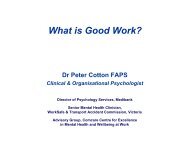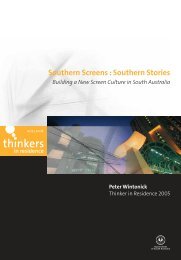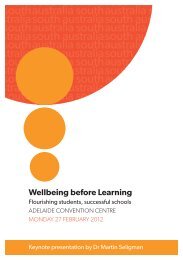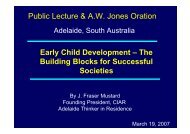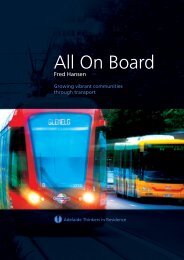Download pdf of Fred Hansen's report - Adelaide Thinkers in ...
Download pdf of Fred Hansen's report - Adelaide Thinkers in ...
Download pdf of Fred Hansen's report - Adelaide Thinkers in ...
- No tags were found...
Create successful ePaper yourself
Turn your PDF publications into a flip-book with our unique Google optimized e-Paper software.
A US study <strong>in</strong> Portland 2 , Oregon evaluat<strong>in</strong>g transit-friendly neighbourhoods (and therebywalk-friendly neighbourhoods, because every transit trip both beg<strong>in</strong>s and ends with awalk<strong>in</strong>g trip) found that residents weighed nearly 6 pounds (2.7 kilos) less than residents<strong>in</strong> non-transit-friendly neighbourhoods. And significantly, this extra weight translateddirectly <strong>in</strong>to additional health costs – about US$5500 per year per resident.With the cost <strong>of</strong> health care skyrocket<strong>in</strong>g <strong>in</strong> most places around the world, and the cost <strong>of</strong>provid<strong>in</strong>g health care here <strong>in</strong> South Australia threaten<strong>in</strong>g to consume greater and greatershares <strong>of</strong> the state’s budget, these trends must be stopped and reversed.particularly among younger generations just enter<strong>in</strong>g the workforce. In turn, thoseemployers will seek to be located closer to their exist<strong>in</strong>g and future workforce.The advantages <strong>of</strong> liv<strong>in</strong>g and work<strong>in</strong>g <strong>in</strong> these vibrant communities will also attract youngand creative <strong>in</strong>dividuals who want to make their mark, start a bus<strong>in</strong>ess or launch a newventure. All <strong>of</strong> this will produce a spirall<strong>in</strong>g force, mak<strong>in</strong>g these communities becomethe future <strong>of</strong> <strong>Adelaide</strong>. In addition, these new communities can revitalise and stimulateeconomic activity <strong>in</strong> areas long neglected but with great potential.People liv<strong>in</strong>g <strong>in</strong> these areas will also benefit by not spend<strong>in</strong>g money on unnecessarytravel. Likewise, with these developments becom<strong>in</strong>g attractive places to live and work,property values will rise. For the vast majority <strong>of</strong> our population, the largest equity<strong>in</strong>vestment they have is their home. The ris<strong>in</strong>g value <strong>of</strong> the home <strong>in</strong>creases the ability toachieve aspirations; everyth<strong>in</strong>g from mak<strong>in</strong>g the home <strong>in</strong>to what they want and pursu<strong>in</strong>grecreational opportunities to help<strong>in</strong>g to send their children to university.I N T R O D U C T I O NInfrastructure – a different approachThe key to mak<strong>in</strong>g this work is the <strong>in</strong>frastructure that determ<strong>in</strong>es how neighbourhoodsdevelop and evolve. If there are only roads and streets, then the only choice is to drive toone’s dest<strong>in</strong>ation. If there are footpaths, safe street cross<strong>in</strong>gs, safe and substantial bikelanes and paths, then people have choices about how they get to their dest<strong>in</strong>ations. Andthose dest<strong>in</strong>ations – the grocery store, the c<strong>of</strong>fee shop, the restaurants, the school fortheir children, and hundreds <strong>of</strong> other shops, services and recreational activities – must beaccessible by walk<strong>in</strong>g and bik<strong>in</strong>g.A new and more attractive wayIt is the responsibility <strong>of</strong> those guid<strong>in</strong>g the future <strong>of</strong> the greater <strong>Adelaide</strong> area todemonstrate how a different development pattern – one that is denser aroundnodes, has mixed use activities, excit<strong>in</strong>g and <strong>in</strong>vit<strong>in</strong>g open spaces, and substantialhigh value employment opportunities <strong>in</strong> addition to service jobs associated withexpand<strong>in</strong>g retail activity – will not only meet the current needs <strong>of</strong> our populationbut will also achieve a vision for <strong>Adelaide</strong>’s future.And these efforts must be focused not on a s<strong>in</strong>gle pattern for what a new developmentmust look like – it must embrace a variety <strong>of</strong> patterns that give people choices for how tomeet their <strong>in</strong>dividual aspirations.As this new style <strong>of</strong> development is built we will see <strong>in</strong>dividuals and families seek<strong>in</strong>gthem out, hav<strong>in</strong>g grown weary <strong>of</strong> need<strong>in</strong>g a car for even the simplest travel needs. Asmore residents arrive <strong>in</strong> these developments, bus<strong>in</strong>esses will also seek nearby locations tocater to them. Employers seek<strong>in</strong>g to attract and reta<strong>in</strong> good employees also understandthe value <strong>of</strong> time, and that us<strong>in</strong>g that time for longer commut<strong>in</strong>g trips is not attractive,2Presentation by Mel Rader <strong>of</strong> Upstream Public Health, to the Jo<strong>in</strong>t Policy Advisory Committee onTransportation, METRO, Portland, Oregon, USA (10 September 2009)2 FRED HANSEN: ALL ON BOARDFRED HANSEN: ALL ON BOARD 3




